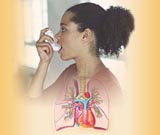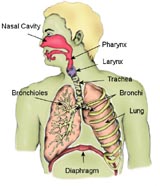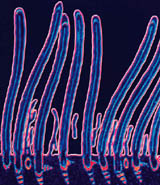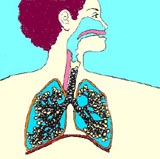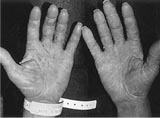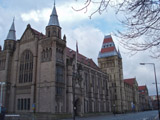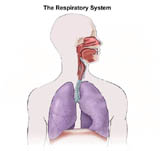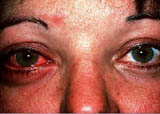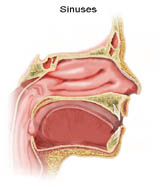Specific diseases
Management of mucus-related respiratory problems through sinus and airway cleaning exercises
Editor's note
The article is the result of a search by the author to cure himself of a crippling asthma, sinusitis and resultant conjunctivitis. He left his legal practice to pursue health. He succeeded. Now at the age of 72 he is fitter than a 40 year old. He hopes to spread the message that it is possible to live without repeated courses of antibiotics, bronchodilaters or nebulisers if you are willing to do exercises.
Magnitude of asthma
According to various sources, mucus-related respiratory health problems, such as the common cold, sinusitis, rhinitis, conjunct-ivitis; COPD, asthma, etc. are on the increase. Hundreds of millions of people suffer every day from chronic respiratory diseases. According to the latest WHO estimates (2007), currently 300 million people have asthma, 210 million people have chronic obstructive pulmonary disease (COPD), while millions have allergic rhinitis and other often-underdiagnosed chronic respiratory diseases (1). It is more prevalent in metropolitan areas due to the increase of industrialisation, emission of gases from traffic and expansion of residential areas, etc. Added to this, higher humidity levels in the atmosphere are also playing a major role. It is claimed that asthma varies from place to place depending upon the presence or absence of allergens and humidity levels. In addition to the above, those people working in industrial units become chronic patients of allergic rhinitis, asthma and other respiratory tract problems due to the continuous atmospheric pollution. Since the conditions under which they work continue to be polluted, there is further scope for aggravation and the spread of infections from the upper respiratory parts, sinuses to the whole of the tracheo-bronchial tree including the air sacs (about 300 million). As a result, the airways become thick and the air sacs weak. The walls between them may get damaged causing other serious problems. With inflammation, excess mucus and narrowed airways, gas exchange between the air sacs may become difficult. The oxygen supply through capillaries may get disturbed.
These days, swine flu pertaining to the H1N1 virus is also causing concern amongst the population. Swine flu is a respiratory tract infection. As and when a person is attacked with this flu virus, the upper airways become inflamed and, as a prominent feature of this inflammation, excess mucus forms. If immed-iate steps are not taken to drain out the excess mucus and bring the inflammation under control, the problem may aggravate and lead to morbidity and mortality.
According to newspaper reports, American scientists have recently discovered a new upper respiratory tract infection caused by Fusobacterium with symptoms of unilateral neck swelling, rigours, night sweats or high fevers. It is claimed that the Fusobacterium is associated with a rare but life-threatening complication called the Lemierre syndrome. It may also lead to greater morbidity and mortality. It is an inflammatory disorder and is controlled by strong medicines.
In spite of the manufacture of improved medicines, the problems of sufferers are not being properly addressed. Hospitalisation is on the increase. Control of asthma and other respiratory diseases have become difficult for low and middle-income people and have become a burden on their resources. So there is an urgent need to investigate and find alternative and complementary methods to confront this situation.
My own efforts have been first directed at learning about the breathing system in the human body. From reading medical books from the American Lung Association and journals and publications by US and British health organisations aimed at family health and other such health magazines, I have come to better understand the physiological phenomena in the respiratory parts, the defence mechanisms provided by nature, the relationship between upper and lower respiratory tracts and their reaction to allergen and humidity levels, etc. With this background, I have evolved some exercises to combat these afflictions. They are based upon deep breathing, gravity-assisted lobar positions and techniques of breathing out. Through these exercises, the sinuses and bronchial airways can be cleaned of excess mucus, (the ground for infections) and any inflammation can be brought under control within minutes. The exercises have helped me at controlling allergic rhinitis, asthma and other mucus-related respiratory health problems. I myself have found much relief from them and have completely stopped using steroids by pursuing a regular regime of exercise. I am able to sleep well without any symptoms of asthma. There is no scope for any infections to develop in my airways.
Our defence mechanism
Nature has provided a defence mechanism in the body to protect us from invading allergens and other organisms:
1. When we breathe in air through the nasal passages, the air is filtered by cilia and sent to tracheo bronchial tree.
2. When the air breathed in is extremely warm, it gets cooled and if it is extremely cool, it gets warmed.
3. If the air is dry, it is moisturised.
4. When air reaches the air sacs through the airways, the oxygen is separated from it and carried to the heart and from there through capillaries to various parts of the body. The oxygen nourishes and replenishes every part of the body and carbon dioxide is exhaled.
5. Goblet cells and small glands within the lining of the nasal passages secrete the necessary mucus. This lubricates the walls of the nose and throat. The humidified mucus traps bacteria, dust and other particles entering it.
6. The cilia mechanically remove inhaled debris and micro-organisms entrapped in the mucus, etc.
This system functions well without our awareness. Many organisms are either dissolved by the chemical elements in the mucus or transported to the entrance of the throat by the tiny hair-like structures called cilia, as already stated. The defence mech-anism attempts to expectorate the excess mucus from the airways through coughing and sneezing reflexes.
However this mechanism gets disturbed in people with hyper-reactive airways as in asthma. Three things happen:
(1) Inflammation,
(2) Hyper-secretion of mucus and
(3) Broncospasm.
According to medical reports, variability is the chief characteristic of asthma. It is a peculiar disease and one cannot positively predict when it attacks. Sudden eruption is possible. An asthmatic attack may occur at any time while sitting at home, day or night, while travelling in a train, plane or on a scooter, etc. Its intensity varies from place to place and season to season. It is often compared to an unruly mad dog. Unless kept under control and properly managed, it may get aggravated and become deadly. During an attack, a simple wheeze may appear progressing to a shortness of breath and soon afterwards, it may turn into fully-fledged asthma. The symptoms may not necessarily be continuous but can come and go in a day or over some weeks or may disappear within minutes. During a continuance of symptoms particularly while sleeping, changes in the airways may take place and that could lead to severe attack.
(1) Inflammation: it is caused as a reaction to allergens such as dust, pollen, smoke, perfumes, odours, foods, drugs, pathogenic organisms and high humidity levels in the atmosphere, etc. The clinical hallmarks are redness, heat, swelling and pain. It has a role in defence against infection, injury and allergy marked by increase in regional blood flow, immigration of white blood cells and release of chemical toxins. Inflammation is one mechanism the body uses to protect itself from invasion by foreign organisms and to repair tissue trauma.
(2) Hyper-secretion of mucus is the result of goblet cell proliferation in the epithelial walls of the airways. These cells produce excess mucus in upper and lower respiratory airways. Excess mucus production is a prominent feature of inflammation. Inflamm-ation and hyper-secretion of mucus go together.
(3) Broncospasm is also a feature of asthma. It means the smooth muscles around the airways go into spasm and the airways get narrowed. The degree of constriction differs from patient to patient. Depending on the severity of constriction, asthma can be intermittent, mild, moderate or severe. Asth-matic patients with a genetic pre-disposition suffer more.
Inflammation, excess mucus and narrowed airways cause breathlessness in patients. With recurrent attacks, the lung capacity gets reduced as the airways get debilitated and weakened. In addition, obesity and ageing further weaken the airways.
Excessive mucus formation, though initially protective, may itself provide a ground for infections. When disease-causing organisms enter the airways and injure the epithelial walls, the defence mechanism gets activated. Chemicals are released and the walls get inflamed. Mucus secretion increases. Viruses and bacteria that have entered get stuck in the mucus. If there is excessive mucus they do not get ciliated out. The scope for their proliferation now increases. Later, these disease-causing organisms may enter the blood vessels. The affected person may not experience any pain or suffering in the beginning, but once the organisms enter the system, suffering commences. Patients can suffer from fever, pain, dullness, pneumonia etc. The drainage of excessive mucus from airways before they get infected can prevent complications.
According to Dr. Sarah Herrick, a research fellow, Dr. Robin Gore, a consultant in respiratory medicine and research fellow and Dr. David Thornton, a senior lecturer in the Faculty of Life Sciences at Manchester University who are conducting research (2008 – 2011 ) as a team into the factor of hyper-secretion of mucus, an abnormal production of mucus in the airways is a major contributor to the pathology of asthma as well as other debil-itating respiratory conditions, such as cystic fibrosis and chronic pulmonary obstructive disease. They opine that, no mucus-directed therapies are available for asthmatics and the factors that lead to excessive mucus secretion during both chronic and severe asthma are not understood (2). It appears that serious efforts are being made all over the world by researchers to develop medicines to contain hyper-secretion of mucus at the production level itself. The researchers further state that chronic alterations to the mucus-producing capacity of the asthmatic airways occur as a part of the spectrum of histopathological changes known as airway wall remodelling. The features of airway wall remodelling as a result of mesenchymal interactions have not been investigated in relation to goblet cell hyperplasia (excessive proliferation of cells) and mucus hypersecretion.
Hypersecretion of mucus causes changes in the airways. It disturbs the physiological process. Its viscosity causes extensive ciliary damage and impairs the clearance of mucus. The sticky mucus layer in the respiratory tract provides a ground for pathogenic organisms. The narrowed airways with inflammation hold the excess mucus tightly which inter-feres with respiration.
In these circumstances, clearance of excess mucus becomes an extremely important factor for airway integrity.
Methods and exercises
Exercises are powerful therapeutic tools. Dr. William Joel Meges, M.D., Ph. D., Professor and Chief of the Division of Toxicology Brody School of Medicines at East Carolina University and Ms. Carol Svec, a fellow researcher, stated in their book, The Inflammation Cure, “If we could bottle the benefit of exercise, it would be the most potent medication in history. People who exercise have fewer physical disabilities and they seem to delay ageing disability by about 15 years(3).” A host of studies proved that exercise protects against chronic disease, extends life, and leads to a better quality of life as we age.
According to them, the latest discovery is that exercise lowers levels of the inflammation marker (CRP), C Reactive Protein in the blood. Thus exercise reduces inflammation in the body. There is no age limit to the benefits of exercise. People can start exercising at any age and can continue exercising throughout life. The earlier you start, the better off you will be, but people who do not begin exer-cising until age 75 can still expect to see some increases in life-expectancy. Strenuous exercises on the other hand, can be harmful and suppress immune functions. Both aerobic and strengthening exercises have been shown to decrease levels of inflamm-ation. Ideally both should be part of your weekly routine. One should have a doctor’s approval before starting any intense regimen.
The following are the exercises that were devised by me and helped me remove mucus from my respiratory passages:
Nasal irrigation.
Airway cleaning of mucus
Physical, aerobic, yogic.
Nasal irrigation (hydrotherapy) exercises
1.Take a small glass of warm water mixed with a pinch of common salt, bend the body forward to about 80 - 90 degrees and snort in water through the nasal passages. Spit out the water which collects in the mouth.
2.Take a small glass of warm water mixed with a pinch of common salt, bend down the body forward to about 80-90 degrees, breath out the maximum amount of air through the mouth so that the nasal passages become free from air, then snort in water till the water goes deep into the nose. Spit out the water collected in the mouth. The ethimoidal, frontal, maxillary and sphenoid sinuses get stimulated and this results in sneezing. This sneezing is a protective reflex indicating the presence of mucus. After a few minutes, the mucus gets collected in the nasal passages and it can be blown out easily.
3.Take warm water as stated above, into the mouth. Bend the head backwards till the trachea gets stretched and open the mouth wide so that the water touches the oro-naso-pharynx and gargle here for a few seconds. Then try to push the water out through the nasal passages alternately. The whole of the nasal passages including the sinuses get stimulated resulting in sneezing. After a few minutes, the mucus gets collected in the nasal passages and it can be blown out easily. The mucus dislodging exercises help in draining mucus from airways effectively. I consider this exercise a Brahmastram*.
Airway cleaning of mucus
The exercises to clean the sinuses and airways from excess mucus are based on the concept of taking a deep breath and holding and breathing out as much air as possible through the mouth so that the lungs become empty and hold the breath. I experienced that, on holding my breath for about 30 to 40 seconds, a little mucus came into the mouth from the bronchi. I used to spit it out. During deep breathing, the volume of air intake is greater and when we apply pressure in breathing out with gravity-assisted lobar positions, the excess mucus in the airway walls gets detached and pushed into the nasal passages and can be blown out easily. This is my concept for treating airway inflammatory diseases.
Physical, aerobic, yogic exercises are done for about 30 minutes.
Results
Nasal irrigation (hydrotherapy) exercise
Cleanses the sinuses , pharynx, larynx, trachea, nasolacrimal duct, etc. from excess mucus.
The defunct cilia start functioning.
Cleaning the airways of mucus (mucus dislodging) exercises
Drain out excess mucus from upper and lower airways including the air sacs.
Physical, aerobic, yogic exercises
The strengthen the respiratory muscles and improves lung capacity, helping to remove inflammation of airways.
As a result of these exercises, any asthma, upper respiratory tract infections, rhinitis, sinusitis, pharyngitis, laryngitis, tonsillitis, conjunctivitis, etc. can be brought under control and prevented from spreading to the other parts. Likewise, lower respiratory tract infections including life-threatening influ-enzas, chronic bronchitis, pneumonia, etc can also be brought under control and prevented from becoming serious.
Furthermore, the whole of the respiratory tract, starting from nasal passages to alveoli, can be freed from obstructions and air-flow into and out of the lungs can be made easier.
As a patient with allergic rhinitis and asthma for the last 39 years, I am able to do these exercises even at the age of 71 years and clean the sinuses and airways from excess mucus resulting in normal breathing. I am sleeping well without any symptoms of asthma.
As an allergic rhinitis and asthma patient, I had been suffering from allergic conjunct-ivitis for the last 15 years due to which my eyes used to become red, swollen, itchy and watery. I used eye-drops including steroids as advised, but the problem continued. Eye specialists advised that the conjunctivitis would continue for several months in a year and for ever as I was a chronic patient of allergic rhinitis and asthma. But with nasal irrigation (hydrotherapy) exercises partic-ularly the third one, the allergic conjunctivitis has come under control. Now, I am able to eat all the restricted foods.
Analysis
When we inhale, the air goes in through the nostrils, up through the nasal passages, down the throat (pharynx) to the wind pipe (trachea), and through the tree-like bronchial tubes, to the tiny air sacs of the lungs where oxygen diffuses into the blood. This pathway is called the airway.
In the entire breathing system, the sinuses play an important role. The sinuses and airways in the tracheo-bronchial tree constitute only one pathway. Even though the sinuses are apart from the lungs, they are considered to be the guardians of the lungs. Any mucus-related respiratory health problems first affect the sinuses, pharynx, larynx and trachea and then the airways in the tracheo-bronchial tree. The cilia in the airways become defunct when there is excessive mucus formation or when the airways get remodelled and debilitated due to severe asthma. The viscosity of the mucus aggravates the problems. Antibiotics may be ineffective at treating the chronic infections that develop thereby. The mucus has to be liquefied for the antibiotics to work. Since sinuses affect the airways, once the sinuses are cleaned of excess mucus, the airways also get cleaned. The defunct cilia become active and flush out the mucus towards the nasal passages. The exercises stated above help in cleaning the sinuses and airways. They are controlling and preventive. Practice of this way could also reduce the economic burden in cases of chronic respiratory diseases.
References
1. http://www.who.int/respiratory/en/
2. Herrick, S. Dr., Gore, R. Dr., Thornton, D. Dr. Hypersecretion of mucus in asthma, 2008 –2011 Research Assistant. http://www. drhadwentrust.org/cms.php?page=12.
3. Meggs, W.J., Svec, C. The Inflammation Cure. Mc Graw Hill, New York; 2003, pp. 154-55.
Bibliography
1. Johnson,G.T. what you should know about health care before you call a DOCTOR. New York; MC Graw Hill, 1975.
2. Faelten, S. & the editors of Prevention magazine. The ALLERGY self-help book. Pernsylvania; Rodale Press Inc., 1983.
3. The editors of The Consumer Guide with IRA. Chasnoff, J., Fainman, Z.S., Ellis, J.W. The New Illustrated Family Medical and Health Guide. Lincolnwood, USA; Louis W Eber, C.E.O. Publications Inter-national, Ltd., 1991.
4. Morgan, P. Saucer, E.T. The editors of Prevention magazine Health books. The female body ( A head to toe guide to good health and body care). Pennsylvania; Rodel Press., Inc. Emmaus, 1996.
5. The American Lung Association Asthma Advisory Group with Edleman, N.H. Family Guide to asthma and allergies. USA; Little Brown & Company, 1997.
6. Kemper, D.W., the Healthwise staff, Smith, T., Editor. Pacificare — Taking Charge Of Your Health. USA; Healthwise, 1997.
*A powerful weapon
Mr. M. Prakash Rao is an advocate living in Hyderabad. He can be contacted at [email protected]
Share with us (Comments, contributions, opinions)
When reproducing this feature, please credit NAMAH, and give the byline. Please send us cuttings.
